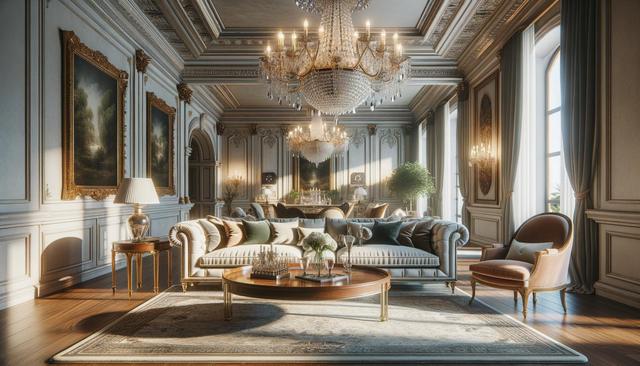Understanding the Concept of Luxury in Home Furnishing
Luxury home furnishing goes beyond simple decoration or utility. It represents a curated lifestyle that values aesthetics, comfort, and enduring quality. Unlike mass-market furniture, luxury pieces are often handcrafted or produced in limited editions, ensuring exclusivity and refined detail. What defines a furnishing as ‘luxury’ often includes the use of premium materials, meticulous construction techniques, and a design philosophy that prioritizes originality and longevity.
Several key factors influence the luxury label in interior furnishings:
- Material quality: Use of premium woods, metals, textiles, and finishes
- Design uniqueness: Custom or limited-edition pieces crafted by renowned designers
- Craftsmanship: Handcrafted elements that showcase skill and tradition
- Longevity: Built to last both in terms of durability and style
Choosing luxury furnishings also involves considering the harmony between different elements in a room. A high-end leather sofa, for instance, may be paired with a marble coffee table or artisan-crafted lighting to create a cohesive and elegant space. It’s not merely about price, but about the story, detail, and experience each piece brings into the home.
Materials That Define Luxury
The materials used in luxury furniture play a central role in its appeal. Natural elements like solid wood, stone, metal, and high-quality fabrics are common in this category. Each material contributes not only to the visual appeal but also to the tactile experience and durability of the furnishings.
Here are some commonly used luxury materials:
- Hardwoods such as walnut, oak, and teak for their grain, strength, and warmth
- Natural stones like marble, granite, and travertine for unique veining and elegance
- Metals such as brass, bronze, and stainless steel for accents and structure
- Textiles including silk, velvet, and premium leather for softness and depth
These materials are often sustainably sourced and meticulously processed to ensure the finished product meets high standards. For homeowners, investing in such pieces means embracing a lifestyle of grace, refinement, and responsibility. The blend of these materials also allows for diverse stylistic expressions—from modern minimalism to classical opulence.
Styles That Speak to Sophistication
Luxury furnishing styles are as diverse as the homeowners who choose them. Some gravitate towards timeless, traditional designs filled with ornate detailing and rich finishes. Others prefer the sleek lines and functionality of contemporary pieces. Regardless of the chosen direction, the key is consistency and balance within the space.
Popular luxury furnishing styles include:
- Modern Classic: Blends traditional silhouettes with modern materials
- Minimalist Luxury: Focuses on simplicity with a high-end touch
- Art Deco: Features bold geometry, rich colors, and metallic finishes
- Transitional: Mixes contemporary and traditional elements for versatile elegance
Each style offers various possibilities for personalization. Whether incorporating a statement armchair or a minimalist dining set, the goal is to reflect the homeowner’s personality while elevating the overall ambiance. Accessories like sculptures, bespoke rugs, and designer lighting further enhance these style narratives.
Furnishing Different Spaces with Purpose
Luxury furnishings must align with the specific needs and functions of each room. What works in a formal living room may not be suitable for a cozy reading nook or a kitchen. Thoughtful planning and spatial awareness are essential when selecting and placing these pieces.
Common residential spaces and their luxury furnishing considerations include:
- Living Room: Statement sofas, curated coffee tables, and designer lighting
- Dining Room: Artisan dining tables, elegant chairs, and ambient lighting
- Bedroom: Upholstered beds, refined nightstands, and layered textiles
- Home Office: Ergonomic yet stylish desks and storage solutions
In each space, the arrangement must support both aesthetic appeal and practical function. For instance, a luxurious sofa should provide seating comfort while complementing the room’s architecture and lighting. Similarly, storage solutions in a luxury setting should enhance organization without compromising design integrity.
Investment and Maintenance Considerations
Luxury home furnishings represent a significant investment, not only in terms of cost but also in lifestyle and home value. With proper care, these pieces can maintain their beauty and functionality for decades. Understanding how to maintain and protect different materials is crucial for long-term satisfaction.
Maintenance tips for luxury furnishings include:
- Regular dusting and cleaning with material-appropriate products
- Avoiding direct sunlight to prevent fading or warping
- Using protective pads or covers for delicate surfaces
- Professional servicing for complex materials like marble or silk
In addition to maintenance, it’s wise to consider the resale or heirloom potential of high-quality furnishings. Well-maintained luxury pieces often retain value and can even appreciate over time, particularly if they are limited-edition or created by notable designers. This makes them not only a personal indulgence but also a long-term asset.
Conclusion: Crafting a Refined Living Experience
Luxury home furnishing is about more than decorating a space—it’s about cultivating an environment that reflects thoughtful design, superior craftsmanship, and personal taste. For homeowners who value aesthetics and quality, investing in luxury pieces can transform everyday living into a refined experience. With careful planning and attention to detail, each room becomes a statement of elegance, comfort, and individuality.


